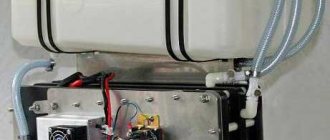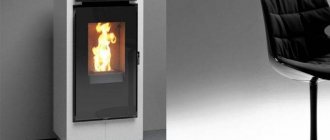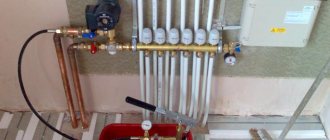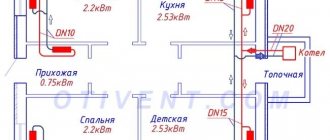For people, an important criterion for choosing a method of heating a home is the amount of costs for installing and maintaining the heating system. Nobody wants utility bills to have a big impact on the family budget.
There is a large selection of autonomous heating systems on the market, which differ from each other in price, complexity of operation, operational efficiency, and environmental impact. Unfortunately, it is difficult to find one that is both cheap, maintenance-free, environmentally friendly and easy to use. Therefore, you need to choose which aspect is more important to you.
What it is?
Autonomous heating is an individual heating system in which all components are installed in the house . Why is this method popular? It's all about saving on utility bills. The owner himself regulates the temperature and heating time, unlike a centralized system, which is also not efficient and sometimes does not provide the proper level of heat. There are also frequent cases of accidents and preventive maintenance.
To install individual heating in a private home, you just need to purchase the necessary equipment.
Autonomous heating systems for a private house using electricity
Currently, few systems can compete with heating using liquid coolant. However, in some cases it is possible to use electric heating, in which heat from the source is immediately transferred to the air without the participation of a coolant.
Such systems now use a variety of equipment, for example:
- cable and film systems for floor or ceiling heating;
- infrared emitters;
- convectors;
- thermostats and programmable devices.
But all such heaters work as independent devices, and therefore each of them can only heat the room in which it is located. And this means that in order to heat the entire private house, there must be several such heating devices.
It is important to understand that any power outages will lead to rapid cooling of the premises. To prevent this from happening, you should stock up on emergency power sources, for example, high-capacity batteries.
Classification
The main element in autonomous heating systems are heating boilers. They are distinguished by the type of fuel used:
- gas;
- electrical;
- solid fuel;
- liquid fuel.
Regardless of the type of boiler, all autonomous systems operate on the same principle:
- Fuel is loaded into the boiler.
- The boiler then burns it, thereby heating the water.
- Heated water is passed through pipes.
- Pipes with hot coolant heat the room.
The total cost of a heating boiler takes into account not only the price of the fuel itself, but also the efficiency of its supply equipment. The higher it is, the more heat you can get.
In terms of year-round performance, devices with less processing power are preferable. It is advisable to choose a boiler with automatic control, which adapts the characteristics to the prevailing conditions and allows you to save money. For the correct and economical functioning of the heating system, you also need to fine-tune its operation.
To reduce costs, it is recommended to choose a high-capacity boiler, such as a wood gasification boiler or a modern and fully automated biomass unit.
Remember that a fireplace or stove can be an excellent additional source of heat in the home that will reduce heating costs. It makes sense to choose a device with storage capabilities. Heat can also be distributed throughout the home using an air heater system or a power source in a water jacketed fireplace.
Currently exotic types of heating
There are several options that can be considered as alternative heating for a private home using modern advances and technologies.
These include:
- use of biofuel for heating the boiler;
- installation and installation of heat pumps;
- heating using solar collectors;
- infrared heating.
Biofuel boilers
Biofuel boilers use pellets, wood pellets, and straw pellets to heat the coolant. The supply of such fuel can be easily automated. It should be noted that such automation can be an order of magnitude higher than the price of the boiler, and pellets, granules and briquettes are very expensive.
Heat pumps
Geothermal pumps extract heat from the environment. Their operating principle is described in detail on many websites. Comparison of savings relative to gas heating in favor of a heat pump. Savings reach 15%. The costs of creating a system using a heat pump are very high. In addition, it requires a reliable power supply line to operate. You can supply your own generator, but this is an additional expense that can reduce the entire benefit to zero.
Solar collectors
Solar collectors are specially designed flat plates containing a coolant inside. It is heated by the sun's rays and transfers thermal energy to the heat exchanger. The heat is accumulated in the heat exchanger tank and used for domestic needs and heating.
Electric heating
This type works on electric boilers. Its advantages:
- low noise level during operation;
- affordable price;
- reliability of design;
- easy installation.
The service life of electric boilers is 15 years . Heating a house with this system makes it possible to program the air temperature. This can be done using a temperature sensor, which is best installed in the coldest room.
Minuses:
- high cost of electricity;
- the need for constant access to it.
Solid fuel heating
For many years, heating using solid fuels: coal, wood or biomass . Their prices vary and depend primarily on the amount of heat generated during combustion. Accordingly, the more you get, the lower the cost of purchasing fuel will be.
Environmentally friendly, selected coal remains very popular. You usually have to pay a little more for it than a regular one, but for many it is the most convenient heating method. For coal combustion, boilers with storage tanks that automatically supply fuel are provided. Their maintenance is less labor-intensive, unlike boilers, the fuel of which must be prepared manually. Once loaded, the charcoal needs to be replenished every few days.
Energy from renewable sources
The most efficient heating equipment is considered to be one that uses renewable energy. In cold climates, these are primarily heat pumps, which convert free energy from earth, water or air into heat. This, in turn, powers the domestic heating system and heats the water.
A heat pump is one of the most modern heating devices that does not require maintenance, is inexpensive, and environmentally friendly. It is well suited for those who care about comfort.
Autonomous heating with your own hands. Simple, cheap and without pipes
In most modern apartments, even with centralized heating, it is quite cold. Connecting an electric heater is not always advisable, since in addition to paying for heating, you will have to spend a fairly large amount on electricity. Staying in a cold or poorly heated room can have a negative impact on the health of everyone in the household. What is the way out of this situation?
Which is better to choose?
A cost-effective solution for a private home would be gas heating. If there is no access to it, then you should pay attention to solid fuel. The system itself should be built according to a single-pipe scheme with a liquid coolant. By making this choice, you can save a lot on pipe laying and at the same time maintain the ability to control the temperature in each room.
If you want to install heating without pipes and radiators, then a stove made of metal or brickwork is perfect for this.
Main types of heating boilers
The boiler is the most complex and at the same time the most expensive component of the main line. Therefore, its choice should be approached as responsibly as possible. First you need to find out what boiler power is required specifically for your home. This indicator depends on heat loss, the total area of the structure and how the system will be operated.
It is worth noting that all the parameters that are required to calculate power are usually indicated in house designs. Actually, even the diagram of this system should ideally be drawn up in parallel with this project, since many of the openings and openings required for laying pipelines are best provided before the start of construction work, and not after their completion.
For individual heating, one of the following types of boilers can be used:
- on gas;
- electrical;
- liquid fuel;
- solid fuel;
- combined type.
Let's consider each of the options in more detail.
Option #1. Gas boilers
Gas-fired boilers are the most common heating equipment, and in terms of the number of installations performed, they significantly exceed the number of installations of solid fuel and electrical appliances (combined). And all because gas heating is considered the most profitable today, and it also has a lot of advantages.
Thus, such advantages include affordable cost, complete autonomy and high speed of installation work. And if you make simple economic calculations, it becomes obvious that gas heating - when compared with heating using coal, diesel fuel or electricity - has higher efficiency.
Installation takes minimal time to complete as it does not require heavy equipment to begin with. By the way, this also allows you to save on construction work.
Note! The term “full autonomy” means the independence of the home owner from permanently changing heating tariffs (this is set by public utilities), pressure drops in the network, inherent in most modern gas pipelines. It is also important that gas heating can be turned on at any time of the year, regardless of the start of the heating season.
Such autonomous heating systems do not emit soot or slag during operation. For comparison: if you use stove heating, then the appearance of fuel combustion products is inevitable, which not only worsens the interior by settling on surfaces, but also significantly worsens the air quality.
Geothermal heating
Previously, we talked about the basic principles and operation schemes of geothermal heating, analyzed various design options and their features, in addition to this article, we advise you to read this information, read about it here
Video - Gas heating
Option #2. Solid fuel boilers
The main advantages of solid fuel boilers are the low cost of the fuel used and its availability. Although it is quite obvious what their main disadvantage is - they are unable to function completely autonomously, since they require regular loading of fuel and cleaning of the combustion chamber (you will have to do this every day).
The efficiency of solid fuel boilers is significantly lower than gas or, for example, electric ones; moreover, they emit much more harmful substances into the atmosphere. As for the installation scheme, it involves the construction of additional sites where fuel will be stored and a constant waste of time loading it.
Of course, technology does not stand still, and modern devices were equipped with special mechanisms to automatically maintain the required temperature of the working fluid - we are talking about temperature sensors.
Each of these sensors is connected to the damper mechanically, and the damper itself regulates combustion by changing the draft.
And if the temperature of the liquid is above the set point, the damper closes immediately, therefore, combustion begins to occur noticeably more slowly. It is also worth noting that the solid fuel heating scheme for buildings does not provide for connection to the electrical network.
Note! On the current market there are many systems where wood is burned according to the principle of pyrolysis, that is, both wood and wood gas, formed under the influence of elevated temperatures, burn. This gas appears in the fuel chamber and enters through the nozzle. Burns with a bright white (or, alternatively, somewhat yellowish) fire.
This type of boiler has a decent efficiency (about 85 percent), and no soot appears during use, which should also be considered a significant advantage. But pyrolysis heat generators also have disadvantages - the need to connect to the electrical network and the fact that they are more expensive than traditional solid fuel devices.
To eliminate the shortcomings inherent in solid fuel equipment, you can use one simple method used in Scandinavian countries. To do this, connect a thermally insulated accumulator for heated water to the heating circuit, the capacity of which should be 3-10 cubic meters.
When the boiler is operating, the water in this tank will heat up to approximately 90-95 degrees, and then - through a thermostat and a circulation pump - the heating mode will be maintained for a couple of days.
Alternative heating in the house
Previously, we talked about options and schemes for implementing alternative heating for a private home; in addition to this article, we advise you to read this information and read about it here
Option #3. Liquid fuel boilers
To be fair, it is worth noting that such autonomous heating systems are the most expensive among all heating devices, although they also have their fans due to their important positive qualities. And the most important of these qualities is that the operation of the system is completely automated.
In terms of their internal structure and operating characteristics, diesel heat generators are almost no different from traditional heating, which, as is known, is used in private homes. A plastic container is placed in the boiler room or on the site, in which, in fact, the fuel will be stored.
Special fuel drives (mostly made of copper) are connected from this container to the heating device. When used, diesel fuel burns in the boiler and heats the working fluid, which exchanges heat with radiators or other heating devices.
Now let's compare the cost of heating a private house using liquid fuel with other common energy sources:
- natural gas is several times cheaper;
- wood (as well as liquefied gas) is 20 percent cheaper;
- Electric heating costs 30 percent less.
Recently, companies involved in the production of liquid fuel heating equipment have done their best to make this type of heating attractive in terms of economics. Now heating systems do not consume as much diesel fuel (when compared with models produced several years ago), which became possible thanks to the use of control systems for heat generators and burners. The burners themselves have become more economical and technologically advanced; if necessary, they can be adjusted to one or another operating mode of the device. Boiler automation is also very useful and plays an important role in ensuring maximum benefits.
Option number 4. Electric heating
Heat generators powered by the electrical network are considered the most popular in European countries. Of course, Russian electricity tariffs do not yet allow this type of heating to take a leading position among the entire range of heating equipment. But if it is impossible to connect to the gas network for one reason or another, then heating with electricity remains the only possible way to provide your home with heat.
If you use an energy-saving system, you will be able to save up to 60 percent of electrical energy. The operation of such a system is that it accumulates cheaper energy (we are talking about electric tariffs), which in the future is quite enough for 1 day of uninterrupted operation.
The popularity of electrical systems is determined by another significant factor: they look more attractive and can fit into almost any room. Even despite the high price (when compared with alternative equipment), in practice these autonomous heating systems pay for themselves quite quickly (usually it takes no more than two years). Autonomous operation is possible in two modes at once:
- charger;
- direct heating (starting is carried out automatically using a timer).
Video - Which heating boiler to choose?
Another important factor is that during operation of electric boilers no noise, odors or harmful substances are emitted; There is no open fire here either, which is why the boilers have become as fireproof as possible. Installation of such a heating system does not require prior approval from certain authorities, with the exception of permission to disconnect from the centralized network.
We draw conclusions: based on everything said above, we find out that the only drawback of electric heating is the high cost of the energy carrier itself.
Option #5. Infrared heating
Such heating can be suitable under any operating conditions. Indeed, from a natural point of view, all the systems described above do not work entirely correctly: first they heat the air, only then - everything else. In natural conditions, all this happens exactly the opposite.
For IR rays, air is a transparent substance, so they pass through it unhindered and reach surrounding objects. The wavelength of IR radiation can be different, let's consider them in more detail.
Short waves appear when the object emitting them heats up to at least 750 degrees. For rooms with high ceilings, conventional water heating is not suitable, because heated air, as you know, always rises. And if the ceiling height is 250-360 centimeters, then it is better to use hanging IR heaters. To ensure uniform heating, there should be several such heaters at once.
Note! If the ceiling height exceeds 400 centimeters, then, according to experts, it is necessary to use devices with a radiation temperature of 200 degrees or more.
From a structural point of view, such boilers are metal boxes in which heating elements are distributed. The outer surface is treated with special materials, and the efficiency can reach 90 percent. The relief of the surface ensures an increase in heat transfer by two to three times, since the total area also increases. The voids between the housing and the heaters are filled with a thermal insulator (read: complete fire safety).
Video - Alternative heating options











